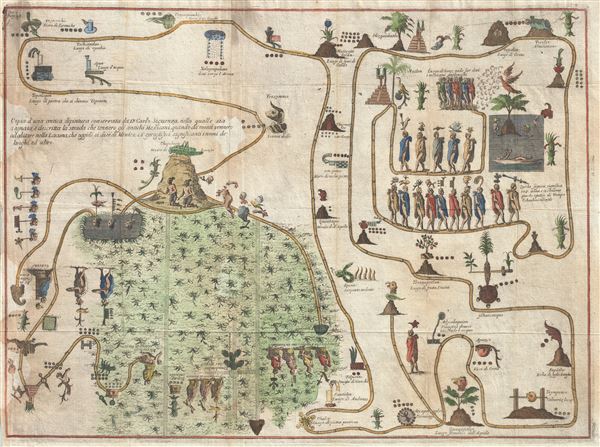This item has been sold, but you can get on the Waitlist to be notified if another example becomes available, or purchase a digital scan.
1721 Gemelli Map of the Aztec Migration from Aztlan to Chapultapec
AztecMigration2-gemelli-1721
Title
1721 (undated) 12 x 16 in (30.48 x 40.64 cm)
Description
According to legend on exactly May 24, 1065 CE, the Mexica (Aztec) began an epic migration from their ancestral homeland, Aztlan, which translated means 'Place of Reeds' or 'Place of Egrets,' to the shores of Lake Texcoco, in Mexico's Central Mesa. There they founded the city of Tenochtitlan which in time spawned the vast Aztec Empire famously encountered by Hernan Cortez several hundred years later. The migration, which seems to have lasted some 250 years, is comparable in scope to the biblical wanderings of the Israelites recorded in Exodus. The legends associated with the Aztec wanderings gave birth to this conceptual map of places and events. Though most of the early stopping points on this map are difficult to correspond with factual localities, the later part of the migration seems to be rooted in the historical with sites like Chapultepec and Lake Texcoco clearly identifiable. Nonetheless, an attempt to reconcile the early points on the pilgrimage was made by no less than the renowned naturalist Alexander von Humboldt. Humboldt was a great believer in indigenous cartographic knowledge and incorporated it into his many important maps – often with significant success. Humboldt no doubt had this very map before him (he references Gemelli) when he drew is seminal 1811 map of New Spain on which many of the stops on the Aztec migration, illustrated here, are noted.
Giovanni Francesco Gemelli Careri was a Neapolitan lawyer and adventurer who spent several years traveling the world in the 1690s. In Mexico, Gemelli was inspired by pre-Columbian culture and dedicated several chapters of his important book Giro Intorno al Mondo to discussing Aztec history and legends. This map, along with Gemelli's equally important representation of the Aztec Calendar, first appeared in the 1704 English edition of his work – presumably Gemelli chose not publish all of his maps and drawing in the earlier Italian edition. Though Gemelli's work attained great fame in Europe, by the end of the 18th century it was considered to be mostly fictional. It was Alexander von Humboldt who, in 1811, resuscitated Gemelli's reputation. In preparing his important map of New Spain Humboldt found himself impressed with Gemelli's in depth geographical knowledge of Mexico, which he understood could only have been obtained through actual experience. This map was published in the English edition of Gemelli's A Voyage Round the World. Neither this map nor Gemelli's important reproduction of the Aztec calendar appeared in the earlier Italian edition of his work.
Cartographer
Giovanni Francesco Gemelli Careri (1651-1725) was a seventeenth century Italian adventurer and traveler. Gemelli Careri was born in a middle class family in Taurianova, Italy, 1651, and died in Naples in 1725. He obtained a doctorate in law at the College of Jesuits in Naples. After completing his studies he briefly entered the judiciary. In 1685 he took time off to travel around Europe (France, Spain, Germany, and Hungary). In 1687 he returned to Naples and re-entered the judiciary. He also began work on his first two books: Relazione delle Campagne d'Ungheria (1689) with co-author Matteo Egizio, and "Viaggi in Europa" (1693). At this time Gemelli experience growing frustrations with the legal profession when he was denied certain opportunities because he did not have an established aristocratic origin. Eventually, he decided to suspend his career for a round-the-world trip. This five year journey would lead to his best known six-volume book, Giro Intorno al Mondo (1699). Gemelli financed his round-the-world venture via various minor merchant ventures, purchasing valuable goods at each strange of the trip. Starting in Egypt he traveled through the Middle East eventually making his way across Armenia and Persia to India and thence to China, where he was introduced to the Emperor. From China he hopped aboard a trading vessel on its way to the Philippines and, crossing the Pacific on a Spanish galleon, landed in Mexico. In Mexico, the Italian traveler became a celebrity by the simple expedient of telling his anecdotes over and over to the local aristocrats. His insatiable curiosity would take him beyond the capital, visiting several mining towns and the ancient ruins of Teotihuacan. Gemelli became fascinated with pre-Columbian culture and dedicated a considerable time and energy to researching studying in Mexico. On his return to Europe in 1699 Gemelli published Giro Intorno al Mondo. Though instantly popular, by the late 18th century his travels were lumped with Mandeville's and presumed to be fictional. Following in Gemelli's footsteps a century later Alexander von Humboldt found that the Italian's lawyer's description of Mexico was so accurate and detailed it could only have been obtained by first hand experience - thus vindicating Gemelli's writings. Gemelli was famously among the first Europeans to tour the world using public transportation; his travels, undertaken for pleasure rather than profit, may have inspired Jules Verne's Around the World in Eighty Days More by this mapmaker...

